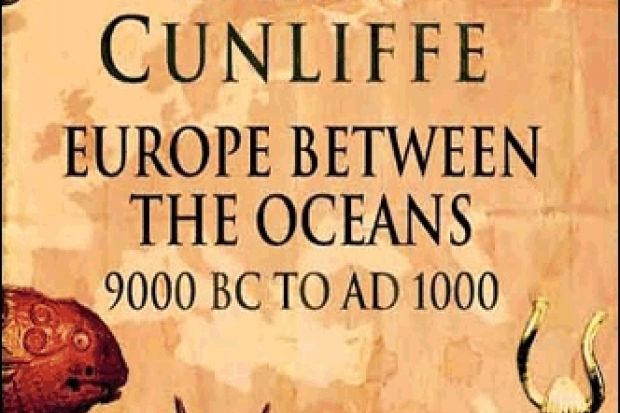Synthesising results from excavations, surveys, studies of great monuments and astonishing new finds to make sense of past human achievements is the duty of every archaeologist. In this Barry Cunliffe is a master craftsman, and Europe between the Oceans is an attractively produced masterpiece that deserves to be read by everyone with an interest in Europe's ancient peoples.
Exploring cultural change over a period of 10,000 years is a strength and a challenge. Starting at 9000BC neatly sidesteps the problems of hominin evolution and recurrent colonisation of the northern hemisphere, for the last Ice Age is over by this time and only anatomically modern humans occupy the land. Equally, AD1000 marks the moment when Europe takes on a modern appearance. The two Christian power blocs of Byzantium in the east and the Frankish Empire in the west separate the Muslim world in the south from the turmoil of folk movements and state formation in the north and east. Between these dates is the real archaeology of Europe; the rest, Cunliffe quips, "is history".
A second strength is the book's wide compass. Helping us step from the modern world into an unfamiliar past, Cunliffe develops the idea that westwards of a line drawn north to south from the White Sea to the Levantine Coast - essentially Arkhangel to Antioch - Europe is simply a peninsula of the Eurasian landmass sandwiched between the oceans implicit to the title: the Atlantic and Arctic to the north, the Mediterranean Sea to the south. Geographers might quibble with the definitions here, but doing so misses Cunliffe's point that "even geography is not what it seems". Using perspectives from 19th-century art and the writings of classical scholars, he explores alternative views of the world; using maps that reject modern Western conventions privileging north at the top further heightens the sense of difference between us and them.
Only in the most general sense is this a "history" of ancient Europe; what we find is literally an archaeology of the past exemplifying a new way of exploring ancient communities. The narrative, the characters and the scenery are brought into focus by combining the physical consequences of specific, and highly personal, human actions of generally short duration found deep in the archaeological record with much longer structural sequences represented at particular monuments and landscapes that transcend the actions of individuals. It is a difficult trick to pull off, as rules guiding the balance between substance and imagination are poorly defined. But Cunliffe treads a measured and convincing path, invoking Fernand Braudel's concept of varying wavelengths in the fabric of time as a means of integrating short-term events with medium and long-term trends.
Painting on a wide canvas inevitably means selectivity. The five chapters dealing with hunter-gatherer communities, early agriculturalists and the first metallurgists in Europe focus mainly on well-documented sites in western Asia, the Mediterranean coastlands and central/northwest Europe. More could have been said about the occupants of the forest zone across eastern Europe, and also the Arctic communities of the far north where prehistoric lifestyles continued into modern times. However, with the emergence of Iron Age communities and the rise of the Roman world, Cunliffe is on home territory, roves more widely and draws extensively on a lifetime's personal research. The first millennia BC and AD roll by in six fast-moving chapters documenting the rise and fall of Europe's great ancient empires.
The book contains accounts of familiar sites from Stonehenge in England to Mycenae in Greece; from the Celtic burial at Vix in France to Theodoric's mausoleum at Ravenna in Italy. There is also a good smattering of recently discovered material, including the decorated menhirs of Brittany and the buried landscapes of the Dutch coastlands. Relevant results from bio-archaeology, linguistics and studies of ancient DNA are also skilfully welded into the story at appropriate points.
Describing archaeological material and setting it in order is one thing, but explaining why things were as they were and why they changed is quite another. Environmental considerations such as the influence of rivers, coasts and mountain ranges, and the spread of natural resources, feature strongly in Cunliffe's interpretations, along with population growth and the movement of people between areas. His main driver of social change revolves around the creation and maintenance of social networks that provided contexts for contact and exchange within and between communities. It is an interesting idea that works well here at the general level and deserves further elaboration. Moreover, it provides further evidence that archaeologists are now focusing on writing archaeology at the grand scale rather than trying to use evidence to reach those parts of our past that history, sociology and anthropology never quite satisfy.
Europe between the Oceans 9000BC-AD1000
By Barry Cunliffe
Yale University Press
480pp, £30.00
ISBN 9780300119237
Published 10 July 2008
Register to continue
Why register?
- Registration is free and only takes a moment
- Once registered, you can read 3 articles a month
- Sign up for our newsletter
Subscribe
Or subscribe for unlimited access to:
- Unlimited access to news, views, insights & reviews
- Digital editions
- Digital access to THE’s university and college rankings analysis
Already registered or a current subscriber? Login




